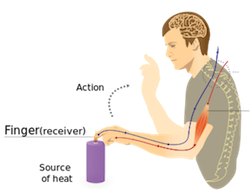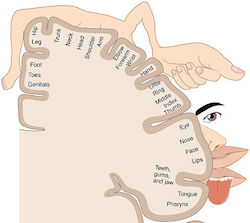Making Sense of Touch

You’re walking around your neighborhood and your friend sees you from across the street. As she catches up to you, you feel a tap on your right shoulder. You turn your head to look over that shoulder to see her smiling, excited to have run in to you.
You can figure out which way to turn your head to see what’s going on behind you because the touch receptors in your skin are organized. Because of this you can tell if you were tapped on the right versus left shoulder. But what if information about touch was not organized? You would feel the tap, but you wouldn’t be able to figure out where it came from. This could be both difficult and confusing, since every time you felt a tap you would need to look all around you to see what was happening. It could even be dangerous if whatever was touching you was harmful.
Mapping the Body
Fortunately, the nervous system is very well mapped. Because of this, it can quickly locate where on the body something is touching you. When something touches the skin, the receptors under that area of skin become more active. This increase in activity tells the nervous system there has been contact in a specific area of skin. But something else happens too. These receptors send a signal to all the other receptors around it. This signal inhibits, or turns down, the firing of these surrounding receptors. This allows the nervous system to figure out exactly what part of your body is being touched.
Receptors that sense touch are located all over the body. But the number of receptors in each location is different, and so some parts of the body have more than others. This difference in receptor number affects the ability to sense touch. An area of skin with a larger number of receptors is better able to sense and locate touch. For example, in sensitive areas, a person can sense two small objects that touch the skin (such as the two tips of a staple) rather than thinking they are only a single object. Scientists call this the two-point discrimination test. You can try out this small experiment yourself to see which areas of the body are more sensitive to touch.

Areas with more receptors are located in places that humans tend to use to explore the world, like the hands, feet, and face. Other areas, like the back and thighs, can also sense touch. But because humans don’t often use these body parts to interact with objects in the environment, there are fewer receptors in these regions.
The Brain’s Touch
Touch receptors send information to neurons in the central nervous system. Most of the signals from touch will travel all the way up to the brain before they can be processed and understood.

In some cases the spinal cord will also process sensory information. This usually happens when the body touches something that could damage it, like a hot surface or sharp object. When this happens, the body will respond differently to try to avoid injury. For example, if you touch something very hot you would pull your hand away as fast as possible. Very fast responses are reflexive, which means they happen without a person being aware of the body doing it.
Even if the information is processed in the spinal cord, it will also go up to your brain. If you recall a time that you touched something hot, you probably pulled your hand away without even thinking about it. It likely wasn’t until after your hand was clear that you realized it hurt. The fast response of pulling your hand away is controlled by the spinal cord. Checking your hand afterwards to see if you are ok happens after the brain receives this information.

Lastly, the brain is organized to keep track of all the sensory information. This organization serves a similar purpose to that of the receptors in the skin – it helps the nervous system figure out where it is touched. When touch information arrives at the brain, it is sorted by the sensory cortex. The sensory cortex is an area of the brain that processes information about touch and other senses. Scientists call the sort of nerve map that is in the sensory cortex a homunculus, or “little man.”
The regions of the sensory cortex that process touch information for each body part are not all the same size. Areas of the cortex are larger if they process information from parts of the body that have more sensory receptors. This means, for example, that the parts of the brain that process touch information for the hands is larger than that for the back. The fact that this organization is similar on the skin and in the brain makes sense. If you have more receptors on one part of the body, the brain will need to have more neurons to process information from that body region.
Candle Image by Bangin.
Read more about: How Do We Sense Touch?
Bibliographic details:
- Article: Making Sense of Touch
- Author(s): Dr. Biology
- Publisher: Arizona State University School of Life Sciences Ask A Biologist
- Site name: ASU - Ask A Biologist
- Date published: 31 Mar, 2016
- Date accessed:
- Link: https://askabiologist.asu.edu/understanding-touch
APA Style
Dr. Biology. (Thu, 03/31/2016 - 00:45). Making Sense of Touch. ASU - Ask A Biologist. Retrieved from https://askabiologist.asu.edu/understanding-touch
Chicago Manual of Style
Dr. Biology. "Making Sense of Touch". ASU - Ask A Biologist. 31 Mar 2016. https://askabiologist.asu.edu/understanding-touch
Dr. Biology. "Making Sense of Touch". ASU - Ask A Biologist. 31 Mar 2016. ASU - Ask A Biologist, Web. https://askabiologist.asu.edu/understanding-touch
MLA 2017 Style

The spinal cord can initiate reflexive responses when touch receptors sense pain or other sensation that might be harmful to the body.
Be Part of
Ask A Biologist
By volunteering, or simply sending us feedback on the site. Scientists, teachers, writers, illustrators, and translators are all important to the program. If you are interested in helping with the website we have a Volunteers page to get the process started.

